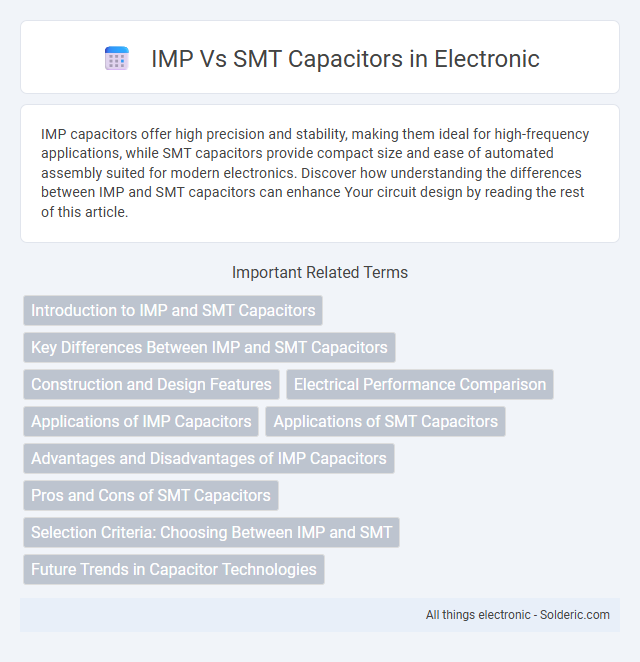IMP capacitors offer high precision and stability, making them ideal for high-frequency applications, while SMT capacitors provide compact size and ease of automated assembly suited for modern electronics. Discover how understanding the differences between IMP and SMT capacitors can enhance Your circuit design by reading the rest of this article.
Comparison Table
| Feature | IMP Capacitors | SMT Capacitors |
|---|---|---|
| Definition | Integrated Monolithic Polymer capacitors with low ESR and high reliability | Surface-Mount Technology capacitors mounted directly on PCB pads |
| Construction | Polymer dielectric with monolithic structure | Varies: ceramic, tantalum, film; multilayer or single layer |
| Size | Compact, suited for high-density applications | Widely range from small chip sizes upwards |
| ESR (Equivalent Series Resistance) | Low ESR improving performance in switching power supplies | Varies; ceramic SMT capacitors have very low ESR |
| Applications | Power management, filtering, decoupling in high reliability designs | General purpose, filtering, decoupling in consumer electronics |
| Reliability | High; stable under thermal and electrical stress | Depends on type; ceramic SMT generally reliable, tantalum less so |
| Cost | Higher due to specialized materials and performance | Generally lower cost and widely available |
Introduction to IMP and SMT Capacitors
IMP capacitors, or Implant Metal Poly capacitors, feature high precision and stability, making them ideal for RF and high-frequency applications. SMT capacitors, or Surface Mount Technology capacitors, offer compact size and ease of automated assembly, widely used in modern electronic devices. Your selection depends on the specific performance requirements and assembly methods in your electronic design.
Key Differences Between IMP and SMT Capacitors
IMP capacitors, often used for high-frequency applications, feature improved impedance matching and enhanced stability compared to SMT capacitors. SMT capacitors, designed for surface-mount technology, prioritize compact size and ease of automated assembly, making them ideal for high-density circuit boards. The key differences lie in their packaging, frequency response, and intended use, with IMP capacitors excelling in precision and performance, while SMT capacitors offer versatility and manufacturing efficiency.
Construction and Design Features
IMP capacitors feature an impregnated winding design where the dielectric layers are saturated with a liquid or solid dielectric material, enhancing voltage endurance and thermal stability. SMT capacitors have a compact, multilayer ceramic or polymer construction with precisely stacked electrodes, offering excellent high-frequency performance and mechanical robustness. The internal structure of SMT capacitors minimizes parasitic inductance, making them ideal for surface-mount applications on printed circuit boards.
Electrical Performance Comparison
IMP capacitors exhibit superior electrical performance with lower equivalent series resistance (ESR) and higher self-resonant frequency compared to SMT capacitors, enabling better high-frequency filtering and reduced signal loss. SMT capacitors typically provide reliable capacitance stability and are favored for compact circuit designs but often face limitations in high-frequency applications due to higher parasitic inductance. IMP capacitors' enhanced voltage handling and improved thermal stability contribute to their suitability in demanding power electronics and RF circuits.
Applications of IMP Capacitors
IMP capacitors are widely used in high-frequency applications such as RF circuits, wireless communication devices, and precision filtering systems due to their low equivalent series resistance (ESR) and superior stability. These capacitors excel in power electronics, offering reliable performance in DC-DC converters and automotive electronics where temperature and voltage fluctuations are critical. Their robust design and high capacitance density make IMP capacitors ideal for aerospace and defense applications requiring compact, durable components.
Applications of SMT Capacitors
SMT capacitors are widely used in high-frequency applications such as RF circuits, mobile phones, and computer motherboards due to their compact size and excellent performance. Their surface-mount design enables automated assembly, improving manufacturing efficiency in consumer electronics, automotive systems, and industrial equipment. SMT capacitors also provide stability and reliability in power supply filtering, signal coupling, and decoupling tasks across various electronic devices.
Advantages and Disadvantages of IMP Capacitors
IMP capacitors offer benefits such as high energy density, compact size, and improved thermal stability, making them suitable for applications requiring reliable performance in limited spaces. However, their disadvantages include higher cost compared to SMT capacitors, potential reliability concerns under extreme environmental conditions, and limited availability in certain capacitance values. Understanding these trade-offs helps you select the optimal capacitor type for your specific electronic design needs.
Pros and Cons of SMT Capacitors
SMT capacitors offer compact size, high reliability, and ease of automated assembly, making them ideal for modern electronics where space efficiency and performance are critical. However, their smaller form factor can lead to lower power handling and reduced voltage ratings compared to IMP capacitors, potentially affecting durability in high-stress environments. Your choice depends on balancing these benefits and limitations to suit your device's specific electrical and mechanical requirements.
Selection Criteria: Choosing Between IMP and SMT
Selecting between IMP (Integrated Multilayer Polymer) and SMT (Surface Mount Technology) capacitors requires evaluating key parameters such as capacitance range, voltage rating, and size constraints relevant to the application. IMP capacitors offer higher stability and lower equivalent series resistance (ESR), making them suitable for high-frequency or precision circuits, whereas SMT capacitors provide compactness and ease of automated assembly ideal for mass production. Consider thermal performance, reliability requirements, and cost efficiency to optimize capacitor choice tailored to specific circuit demands.
Future Trends in Capacitor Technologies
IMP capacitors are evolving with improved high-frequency performance and miniaturization, supporting the growing demand for 5G and IoT applications. SMT capacitors are advancing in energy density and reliability, driven by electric vehicles and renewable energy systems. Your choice between IMP and SMT will shape how effectively your designs adapt to increasing speed and power requirements in next-generation electronics.
IMP vs SMT capacitors Infographic

 solderic.com
solderic.com